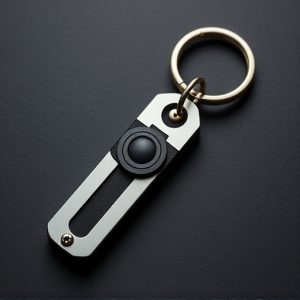Discreet Self-Defense Keychains: Navigating Legal Requirements and Design Strategies
In many places, carrying a keychain weapon requires adhering to specific laws known as Keychain Weap…….
In many places, carrying a keychain weapon requires adhering to specific laws known as Keychain Weapon Permit Requirements, which vary by region. These regulations dictate the type, size, and functionality of allowed weapons, and designers must balance aesthetics with effectiveness while ensuring compliance. Discreet keychains should feature quick-access mechanisms, durable materials like high-strength alloys, ergonomic grips, and features preventing unauthorized use, all while meeting local permit requirements for responsible self-defense.
In today’s diverse and dynamic world, personal safety is a paramount concern. This article explores the discreet personal protection keychain—a innovative solution for self-defense. We delve into the legal aspects of Keychain Weapon Permit Requirements, analyzing regional regulations that shape these tools’ design and use. Furthermore, we dissect the balance between form and function in creating effective, yet unassuming, self-defense devices, emphasizing key considerations for safety and practicality.
- Understanding Keychain Weapon Permit Requirements: A Legal Perspective
- Designing Discreet Personal Protection Keychains: Form and Function
- Key Considerations for Creating Safe and Effective Self-Defense Tools
Understanding Keychain Weapon Permit Requirements: A Legal Perspective
In many regions, carrying a self-defense tool like a keychain weapon is governed by specific legal frameworks and requires adherence to strict regulations, collectively known as Keychain Weapon Permit Requirements. These requirements vary across jurisdictions, but they typically involve obtaining permits or licenses for certain types of personal protection devices. Understanding these legalities is paramount before considering such a discreet defense option.
The Keychain Weapon Permit Requirements often dictate the type, size, and functionality of permissible weapons. They may also include restrictions on where and how these tools can be carried, as well as mandatory training or safety courses for their responsible use. Staying informed about local laws ensures that individuals exercise their right to self-defense while adhering to legal boundaries, thereby fostering a safer environment for all.
Designing Discreet Personal Protection Keychains: Form and Function
When designing discreet personal protection keychains, the balance between form and function is crucial. These miniature self-defense tools must not only be aesthetically pleasing but also highly effective in dire situations. Crafting a keychain that meets the weapon permit requirements involves careful consideration of size, materials, and mechanism. The design should ensure ease of use, allowing for quick deployment without drawing undue attention. Materials like high-strength alloys and durable plastics are ideal for withstanding regular use while maintaining a compact form factor.
Functionality goes beyond just the mechanical aspect. The keychain should seamlessly integrate into daily routines, fitting comfortably in pockets or purses without becoming cumbersome. Discreet features such as a concealed edge or built-in pepper spray can significantly enhance its effectiveness without sacrificing its subtle appearance. Understanding local weapon permit requirements is essential to ensure legality and safety when carrying personal protection tools like keychains.
Key Considerations for Creating Safe and Effective Self-Defense Tools
When designing a discreet personal protection keychain, several key considerations come into play to ensure its safety and effectiveness as a self-defense tool. Firstly, the keychain should incorporate a reliable and easily accessible mechanism for deploying the protective device. This could include a simple flip or twist action that reveals a hidden weapon, such as a small stun gun or pepper spray, without drawing undue attention. The design must balance functionality with discreteness to maintain surprise during an unexpected attack.
Additionally, materials play a crucial role in both the durability and aesthetic appeal of the keychain. High-quality metal alloys are preferred for their strength and resistance to wear and tear, while ergonomic grips ensure comfortable handling. Moreover, considering local laws and regulations regarding keychain weapon permit requirements is essential to ensure legal compliance. This may involve incorporating features that prevent unauthorized use or setting clear guidelines for responsible ownership and storage.
In conclusion, designing discreet personal protection keychains involves balancing form and function while navigating crucial legal considerations like the Keychain Weapon Permit Requirements. By understanding these requirements and focusing on safety, effectiveness, and discretion, creators can develop innovative self-defense tools that empower individuals without compromising their well-being or legal standing.

